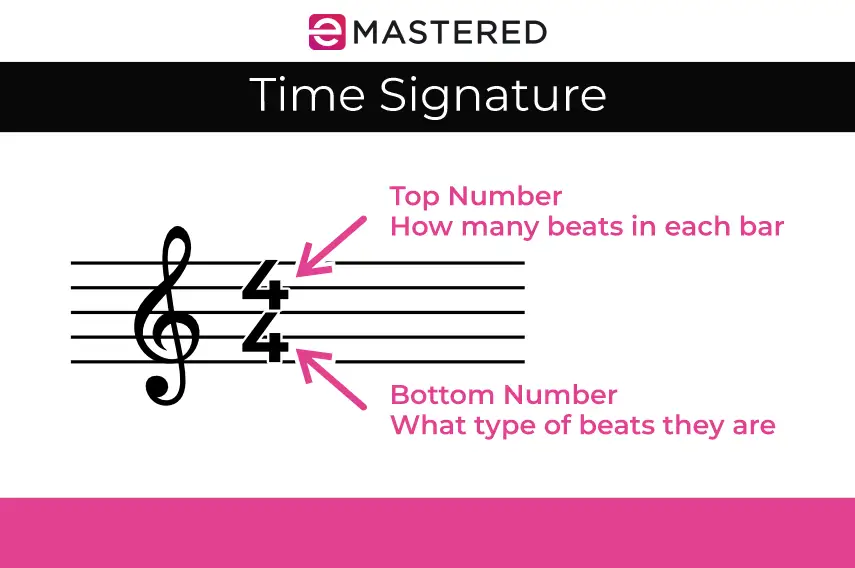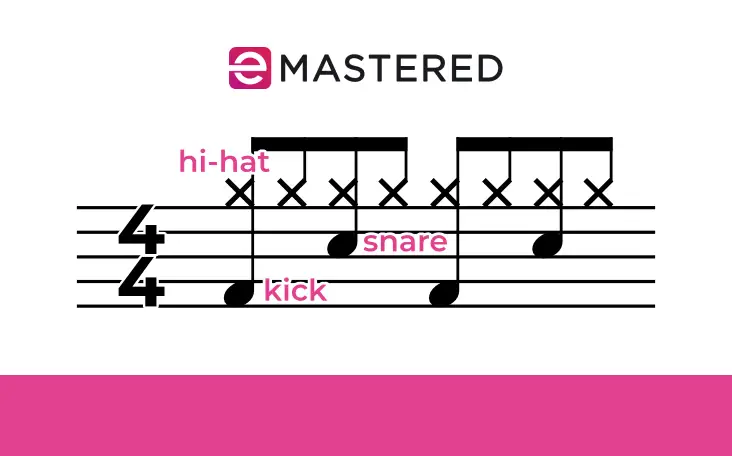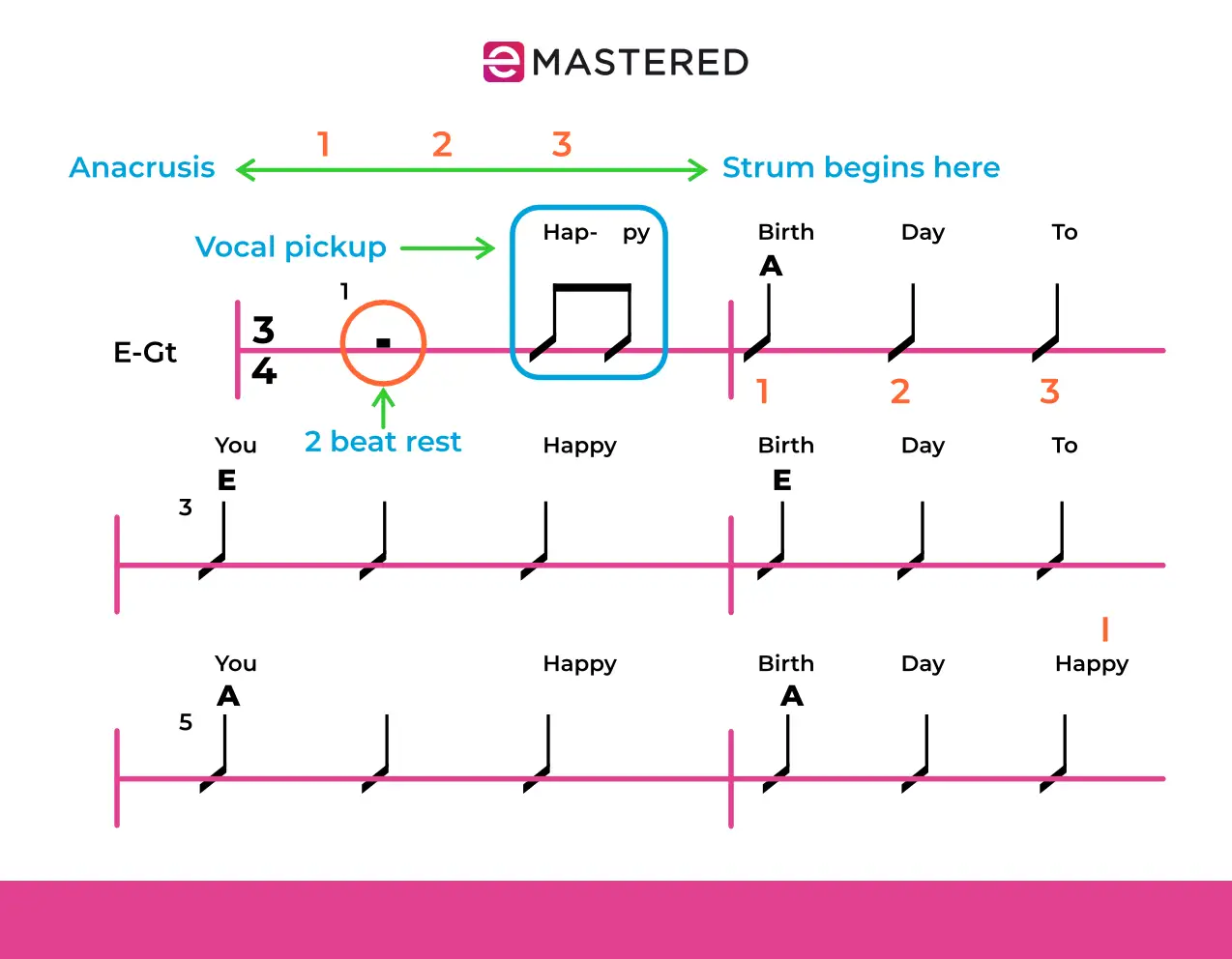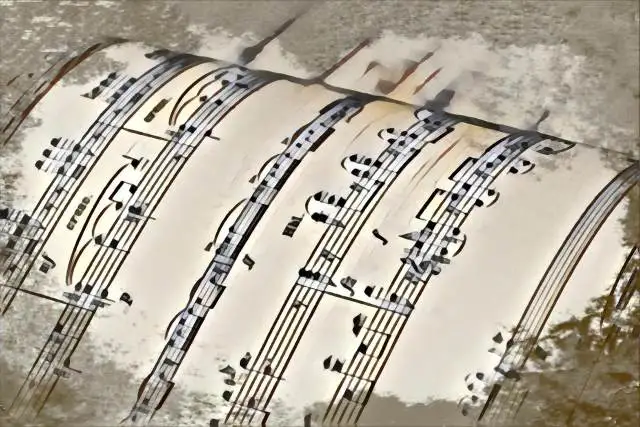Anacrusis is one of those things you’ve heard countless times in songs you love, and yet if someone asks you to explain it through musical notation, you just can't. A tool for composers that’s been around for centuries, anacrusis is a great way to diversify your music and make it more engaging.
Today, we’ll discuss this unique technique, how it works, and how you can use it to enhance and improve your songs. To fully understand the concept, we'll also need to discuss some music fundamentals, but I promise you that I'll keep it brief.
By the end of this article, you might even find out that your favorite song begins with an anacrusis!
Anacrusis Definition
Anacrusis is also called "pickup measure" or "pickup note," and is essentially a note or notes that come before the first complete measure of music, and before the first accented note of a phrase.
The term comes from the Greek word "anákrousis" ("pushing up") and was originally used in poetry to define extra metrical unstressed syllables at the beginning of a verse.
Similarly, in music, the anacrusis prepares the listener for the downbeat (the first beat of the first full measure), allowing the musician to build momentum and make the song more engaging through syncopation.
Anacrusis has been one of those "Western standards" in music for centuries; extremely popular in the Baroque era, less so in Classical music (but still relatively common), and now a technique widely applied across genres.
The pickup measure offers a unique way to introduce the listener to a new melody line without fully revealing it from the start. This can make a song more unpredictable, while also engaging with the listeners and encouraging them to pay closer attention.
Anacrusis: Music Theory to Get Started
This concept is actually easier to hear in music than to explain in words. However, you need to have at least a rough understanding of the concepts of time signature and syncopation . So let’s quickly cover the basics.
The time signature is the number of beats in each measure and which note value one beat has. It looks like a fraction at the beginning of a piece of sheet music.

The number on top identifies how many beats are in each bar (i.e., how many numbers you count in a bar). The bottom number defines the type of beats you'll find in the bar (Minim, Crotchet, Quiver).
If you’re looking for the easiest video that explains this concept clearly, I recommend a great video by Kalani at the World Drum Club. (As a drummer myself, I can confirm that the simplest music theory explanations are in videos made for drummers!)
In a standard 4/4 time, you’d usually have an emphasis on the 1st and 3rd beats, which are called strong beats. These are the beats that define the groove or flow of a song, and here’s an example of a simple 4/4 drum pattern:

If beats 1 and 3 are where the strongest accents are, 2 and 4 are considered weak beats or off-beats, and the same goes for their subdivisions (like the eighth notes).
When you put the accent on an off-beat note, you’re creating syncopation . In simple terms, by putting the emphasis on a beat that’d normally be a weak beat, you disrupt the flow or pattern that your mind associates with the groove, which often results in enhancing the melodic line.
Once again, this is a very basic definition of a rather broad and complex topic, but to understand anacrusis, it should be enough.
To summarize, in very simple music theory terms, an anacrusis precedes the first downbeat of a measure and, by doing so, creates an introductory moment that enhances the flow and rhythm of the piece of music. You'll find it in written music notation as part of the musical form, and it'll look like a note or group of notes before the first measure.
The corresponding number of beats in the pickup measure is typically subtracted from the final measure of the piece, which is a trick to keep the overall piece at a whole number, so that the number of beats in the first measure and the last measure adds up to a full measure.
Often, the anacrusis enhances the flow and structure of an entire piece, building momentum and adding a sense of anticipation to the main melody. As we'll see below, you can find it in every musical genre, from classical music to metal, and the results are always surprising and galvanizing.
Anacrusis in Music
It's time to see how anacrusis looks when you see on paper and how it sounds when you hear it. The easiest and most common example used to describe it is Happy Birthday:

The song starts with the word “Happy", but that’s not when the counting starts: there’s a 2-beat pause before that, followed by two quavers on the words “Hap-py”.
So, if you were to direct a choir to sing Happy Birthday, you should count as follows:
One – Two – Three – One – Two – Hap – py – Birth – day – To - You
With each color representing a bar.
Furthermore, being “Ha-ppy” an upbeat (the last beat of a measure), it’s naturally sung in a softer tone, as opposed to the louder “Birth-day” that starts on the first beat of the measure (downbeat).
Bear in mind that the final bar and first part bar of a piece of sheet music, when summed up together, should equal the time signature:

This means you have to omit a corresponding number of beats from the last bar in order for the music sheet to be correct.
Usually, when the melody is on a loop, you should see a repeat sign at the end of the final bar.
From a music theory perspective, that's all you need to know about anacrusis. However, composers have used this technique in countless different ways, bringing to life complex and incredibly imaginative compositions.
In the following section, we’re going to analyze different anacrusis across different musical genres, to get a better understanding of how this musical tool has been used over the centuries. While there are hundreds of examples available, I chose the most popular ones, as well as those that show how anacrusis can be used creatively to enhance the beauty of a song.
More examples
The Beatles - "Yellow Submarine"
In the iconic Beatles song, the words "In-the" precede the first full measure, making it an anacrusis. This is what gives the song its playful tone before the main rhythm kicks in with "town-where-I-was-born."
François Couperin - Le Tic-Toc-Choc ou Les Maillotins
In Le Tic-Toc-Choc ou Les Maillotins, the first harpsichord phrasing begins with quick notes that precede the first full measure, which help build momentum and an element of rhythmic unpredictability to the Baroque structure of this piece.
Carly Rae Jepsen - "The One"
Imagine counting the beats as follows:
one - & - two - & - three - & - four
In this catchy pop song, the very first note is on the “&” of one. The metronome starts clicking on 2 and 4 like a snare highlighting the two while making it feel like one at first, until the vocals start.
Radiohead – "Videotape"
I’ve listened to Radiohead’s masterpiece "Videotape" dozens of times, and it’s only once you reach the end of the track that you realize the piano chords from the entire song are on the off-beat all along.
Aside from being a timeless song created by a legendary band, Videotape shows how artists can "trick" us listeners into thinking the song follows a certain rhythm, while gradually revealing that we were wrong from the start.
Kendrick Lamar - "How Much a Dollar Cost"
This poignant track starts with piano chords which turn out to be off-beat, precisely on the “&” of one and two. The effect is destabilizing yet extremely engaging once the lyrics start.
This shows you how powerful anacrusis can be when used in looped songs. Here, every element of the song is on a loop, and together, they create a cohesive piece of music with a syncopated beat that pushes the song forward.
Meshuggah - "Combustion"
I saw Meshuggah live a few times, and their time signatures literally blew my mind. However, Combustion's drum groove took my confusion to a whole new level and for a very long time. That was until I realized there was an anacrusis at the beginning of the song. Check out this video to find out more about this confusing metal track.
As you can see from the examples above, composers use anacrusis for various reasons. Often, and especially in classical music, anacrusis has been used to introduce the audience to the main melody as the piece of music begins, without fully revealing it. This is a way to make the next measure more engaging and familiar.
In modern music, it's often used to create a sense of surprise and unpredictability in a piece. As soon as a new song starts, our brain starts working hard to predict the next measure, but when a track begins with an anacrusis, we often can't grasp the right tempo until the beat and melody of the composition align. That could happen seconds after the song's beginning, but as in the case of Mastodon's "Combustion," it could take much longer than that.
Final Thoughts
I hope this guide helped clarify the beauty and complexity of anacrusis, and encourage you to implement it into your music production workflow.
All in all, this musical tool is a great way to add a sense of unpredictability to your compositions, and allow the listener to interpret what they hear in their own way.
By introducing the downbeat with an anacrusis when the music begins, you’re also building momentum, making the song’s beginning more powerful and recognizable.
Finally, applying anacrusis will showcase your skills as a songwriter or music producer, who can go beyond the overused 4/4 time signature to make a musical phrase stand out from the crowd.
Good luck!





